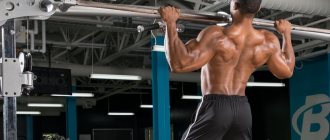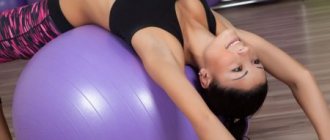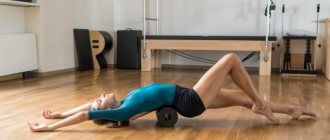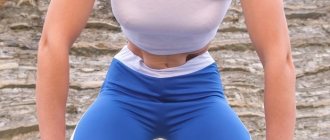Translated from English, this word means “suitable ball”, i.e. The perfect ball to keep your figure in good shape. This is the main fitness equipment.
The Swiss ball (as it is called) develops strength and endurance, coordination of movements, improves blood circulation, strengthens the muscles of the arms, buttocks and other parts of the body, and relieves women of cellulite. This is an excellent prevention against pain in the lumbar region.
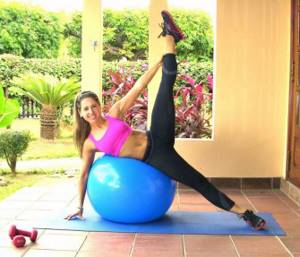
In the article you will learn what to do with this ball, how many times a day and what effect will be achieved.
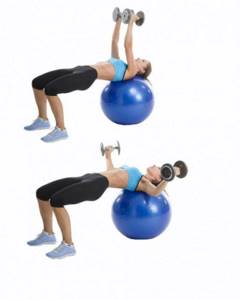
Rules for performing exercises on a “suitable ball”
First you need to learn more about the rules necessary to achieve your goal:
- During training, you should tense absolutely all your muscles and do everything efficiently.
- At the initial stage, when you just started playing this sport, do not inflate the ball too much, then it will be too elastic.
- Weight loss exercises with it do not require additional equipment.
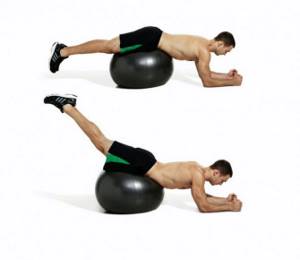
Exercises with a gymnastic ball for the abs
Using a fitball, you can effectively pump up your abs at home. The list of the best abdominal exercises with an exercise ball includes:
- Twisting : lean your lower back on the ball, relax your upper shoulder girdle and back. We cross our arms on our chest, our legs are bent. We perform the usual twisting of the body, rounding the back and straining the rectus abdominis muscle;
- Corner : lie on the floor, resting your shins on the ball (legs form a corner), raise your body and stretch your hands to your ankles, without lifting your lower back from the floor;
- You can also perform abdominal exercises with a fitball on the horizontal : put the ball under the horizontal bar, take the starting position while hanging, pick up the ball with your feet and perform twisting or lifting your legs to the crossbar (advanced version);
- Exercises for oblique abdominal muscles : sit on a ball, close your legs and strain your abdominal muscles. We move the clasped legs to the left, and the arms to the right, maintaining balance with the oblique muscles, repeat for the other side.
Abdominal exercises with a fitball can be made even more effective if you add additional weights and reduce the number of repetitions to 10-12. By exercising regularly, eating well and resting, you can quickly pump up your abs.
How to choose the right ball?
This apparatus is often used by athletes after injuries. It reduces stress on the spine compared to other exercises. There are 3 sizes of bola: 55, 65 and 75 cm. They correspond to the following human height: the first size is suitable for girls no taller than 160 cm. The second is for those with a height of 160-170 cm. The last type is for the tallest from 1m 70 cm to 2 meters .
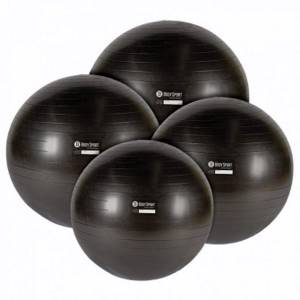
You can take this test: sit on the ball and look at yourself and the ball. If, while sitting on it, your knees and shins form a 90-degree angle, this is ideal. Now you need to consider exercises on this ball.
Benefits of fitball
The popularity of a large inflatable ball provides undeniable advantages compared to other exercise equipment and sports equipment:
- Versatility, which makes it suitable for people of any age, shape, health condition;
- The complex effect on the body ensures that several muscle groups are simultaneously worked out;
- The gentle nature of the exercises, which allows it to be used by pregnant women, children or people undergoing rehabilitation;
- Low cost;
- Multifunctionality, because the ball will be an ideal toy for a child;
- Long service life.
A set of exercises for the lower body
Now let's talk in more detail about exercises on this miracle ball. One of the main exercises in this series is squatting with a ball over your head. This is a regular squat, but with your arms extended upward and holding a huge ball. This exercise perfectly strengthens the muscles of the arms and legs.
The next type is a squat with emphasis on the wall. The fitball is squeezed between the wall and the body. During squats, it rolls along the back from bottom to top - from the lower back to the shoulders. This is how the quadriceps muscle is trained. The exercise, like the previous one, must be repeated 10-15 times.
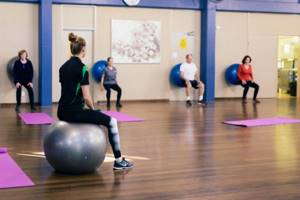
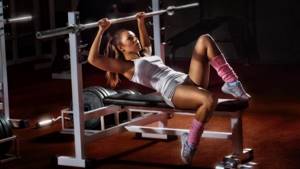
Exercises in the gym - tips for choosing the best set of exercises. Recommendations for beginners and tips on how to practice correctly (85 photos)
A set of exercises for gaining weight - basic exercises and recommendations for selecting weights for exercises
- We perform squats with dumbbells - a description of the technique of performing the exercise. Subtleties and secrets of squats for girls (125 photos)
Exercises of this type include: squats with a fitball clamped between the knees, slow squats with arms extended forward holding the ball, lunges, etc.

If the descriptions of the classes are not enough, you can watch video exercises on a fitball. They will show you all the details.
Core
Start by rotating your body:
- Lie on the fitball with your back, buttocks should not touch the ball.
- Bend your legs at a right angle, spread your feet for balance.
- Extend your arms above your chest and clasp your palms together.
- Roll your body from right to left and back. Keep your hands in one position, do not lift your feet, keep your knees at right angles.
Strengthens the back muscles and the abdominal muscles. The starting position is the same as in the previous exercise, but now the emphasis is on the buttocks, and the shoulder blades do not touch the fitball. Bring your bent arms together and hold them in front of you. As you exhale, lift and stretch your body perpendicular to the floor. As you inhale, lower your back onto the fitball.
To work the oblique muscles, perform a side plank:
- Get on your knees.
- Place a fitball on one side and lie on it sideways. The ball touches the chest, waist and upper thigh.
- Keep your leg bent at the ball and extend the other leg to form a straight line with your torso.
- Place your bent arms behind your head, spread your elbows to the sides.
- Do side bends, lifting your chest off the fitball. Keep your body straight and try not to lean forward or backward.

You can also do a plank on your elbows with a fitball (Photo: www.pexels.com)
The exercise ball is great for strengthening your core. The ball is safe for the lower back and does not pose a risk to the back muscles.
Is fitball an activity for adults?
Let's not forget that the ball is an attribute of childhood.
Children especially love him. When a huge ball rolls up to a child, a smile appears on his face and joy from the upcoming game with him. Yes, doctors even prescribe fitball to their patients-mothers for newborns. This is a game and prevention of many childhood diseases at the same time. Exercises for children on a fitball help reduce painful colic in the baby’s stomach. This is an excellent back trainer and an excellent tool for overall development.
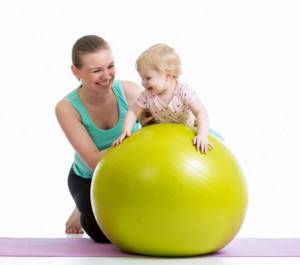
A properly selected set of exercises on a fitball strengthens muscles, promotes their proper development, and helps you get back on your feet faster. Before using a fitball with your baby, consult your doctor.

Upper body
To work your arms and chest muscles, do push-ups. You can lean with your straight arms on the ball (the body and legs form an angle of 45 degrees in relation to the floor) or on the floor. In the second case, the fitball lies under the hips, and the legs and body form a straight line and maintain this position when bending the elbows.
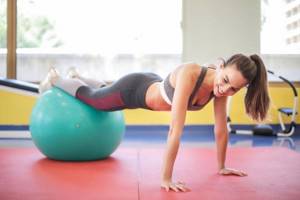
Variant of the starting position for doing push-ups (Photo: www.pexels.com)
It is also convenient to perform dumbbell flyes on the ball:
- Take dumbbells and lie with your shoulder blades on the fitball. The lower back and buttocks do not touch the ball and are kept parallel to the floor.
- Bend your knees at right angles. Spread your feet to achieve a stable position.
- Stretch your arms with dumbbells up.
- As you inhale, spread
- bring your arms together above your chest.
From the same position you can do a French press: place your hands with dumbbells behind your head.
What are the benefits for pregnant women?
In addition to athletes, women who want to lose weight, men and children, fitball is recommended for pregnant women in the second trimester of pregnancy.

Exercises for pregnant women on a fitball promote the proper development of the fetus, reduce back pain, improve the functioning of the respiratory system, and strengthen the pelvic muscles.
During childbirth, there are cases in world practice when this huge ball was used. It helped reduce the pain of prenatal shock. Gymnastics for pregnant women with this attribute is divided into 3 types: lying down, sitting and on all fours.
The benefits of using a fitball
You can perform countless exercises with an exercise ball. Fitball can be called the most universal sports equipment: it is used by women and men of any age and weight category, is prescribed as developmental gymnastics for children, and is also used in exercise sets for pregnant women.
Including fitball in your training complex has many positive aspects:
- improving coordination and correcting posture;
- exercises on the ball are suitable for losing weight and toning the body: constantly maintaining tension while performing a training complex increases the number of calories burned;
- exercises with a ball are good for the spine and joints: by removing the load from them, they promote speedy healing and relief from pain;
- Exercises with a fitness ball bring the necessary variety to the training process, keeping the athlete motivated and interested.
At the same time, the fitness ball is completely safe: a special abs system protects it from rupture under the influence of static and dynamic loads. This allows the fitball to be used safely by overweight people, as well as older people with fragile bones.
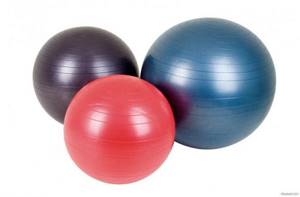
Fitball - health ball
Before you start training, you need to choose the right fitness ball:
- The size of the fitball should correspond to height : small models up to 55-60 cm are suitable for short people, tall people will need a larger ball (from 60 cm or more). A simple check will help determine whether the ball is suitable: we sit on top of it, if a right angle is formed between the legs and thighs, the size is ideal, but if the knees rise above the hips, the fitball is too small;
- Fitballs can have different surfaces : smooth balls are a universal option, models with ears are suitable for beginner athletes and children (they are easier to maintain balance on). Balls covered with rubber spikes intensify the flow of blood to the skin, warm up and massage the body during exercise: therapeutic and restorative gymnastics are performed on such fitballs;
- The degree of density (pumping) of the ball is regulated independently . This way you can vary the load. For effective weight loss, exercises should be carried out on the most elastic fitball: this makes it more difficult to maintain balance and perform exercises. For beginners, it is better to start with exercises on a weakly inflated fitball.
Ball exercises before, during and after pregnancy
Now we will talk directly about the exercises themselves on the fitball during pregnancy. The most common exercise is lying on your side.

The best dumbbell press - advice from professionals and basic variations of the basic exercise (75 photos)
How to do the plank exercise? Step-by-step description of the correct technique and features of the exercise
- Yoga stretching exercises - complexes for beginners and stages of achieving high results (110 photos and videos)
Side exercises on a fitball are performed as follows: a woman lying on her side raises her upper leg onto the ball. The maximum number of times is 10, 2 approaches on each leg.
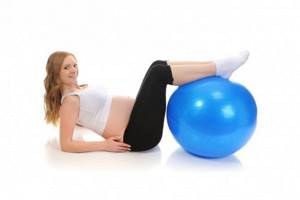
Jumping on top of a ball is very effective. This should be done slowly and smoothly. Postpartum exercises on a fitball are also no less useful for every woman in labor.

Fitball for losing weight
For those who want to get their body in shape and lose excess weight, fitball will be the best assistant. The most intense workouts promise visible results within 2 weeks.
Below is one of the exercises on a fitball for weight loss:
- Lie on your back, extend your arms at your sides, and place your legs bent at the knees on a gymnastic ball.
- Hold the fitball between your legs.
- Lift your pelvis off the floor and, tensing your abdominal muscles, pull your knees to your chest.
- Having reached the maximum position, hold for 10-30 seconds and return to the starting position.
- To make the abdominal exercise more difficult, lift the exercise ball with your feet while simultaneously lifting your shoulders and head off the floor.
- The exercise should be performed in 2-3 sets of 10-20 times.
Photos of exercises on a fitball

Facial exercises - types of the best procedures and techniques for performing the exercises necessary for a facelift (135 photos and videos)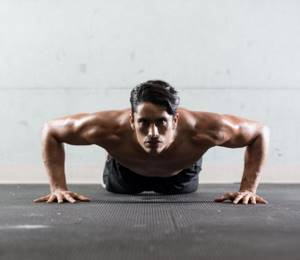
Review of exercises for men - the most effective comprehensive workouts at home and in the gym (120 photos and videos)

A set of exercises on simulators - programs for beginners and training tips for women and men (105 photos)
Exercises for losing weight on the abdomen and sides
Regular exercises using a special ball in a sitting or lying position help strengthen the abdominal muscles. They get rid of excess belly fat, tightening it and making it attractive.
They also help to work the deep and oblique abdominal muscles, which are rarely used during classical training. It is worth noting that exercises on a special ball are not dangerous, since the fitball relieves the load on the lumbar region.
Crunches
This exercise will help pump up your rectus abdominis muscles.
It must be done in the following sequence:
- Sit comfortably on the fitball. Bring your legs together and place them in front of you.
- Cross your arms over your chest or place them behind your head (do not clasp your fingers).
- Take a breath. As you exhale, tense your abs, slowly tilting your head forward, then your shoulders and body. Press your chin lightly towards your chest.
- While inhaling, return to the original position.
The lower you tilt your body forward, the more effective the stretching of the abdominal muscles will be.
Hyperextension
This exercise helps pump up your abs and develops your back muscles.
It should be performed in the following sequence:
- Lie down on the fitball so that your stomach and pelvis are completely placed on the ball.
- Place your hands behind your head without interlocking your fingers.
- The body should form a straight line.
- As you inhale, bend back to the most comfortable level.
- When exhaling, return to the original position.
When performing the exercise, you cannot help yourself with your hands, and also keep your abdominal muscles tense for a long time.
Transferring a fitball from hands to feet
Due to its complexity, this exercise is recommended only for those people who have good physical fitness.
Sequencing:
- Lie on your back on a mat or small rug. Legs should be straight.
- Raise the fitball above your head without bending your elbows.
- Tighten your abdominal muscles and slowly sit down.
- Turn to the left and then to the right.
- Lower the fitball and hold it between your knees.
- Without bending your legs, return to the mat in a lying position.
- Tighten your abdominal muscles and slowly rise to a sitting position.
- Take the ball and turn your body with it to the left and right.
- Return to original position.
The training should be carried out without jerking, smoothly and leisurely.
